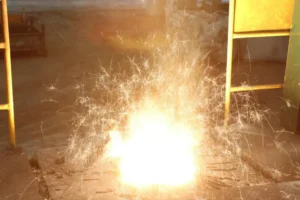ในด้านการแปรรูปความร้อนจากอุตสาหกรรมที่ทันสมัย, เตาเหนี่ยวนำมีบทบาทที่ขาดไม่ได้เนื่องจากมีประสิทธิภาพสูง, ความสะอาด, และความแม่นยำ. อย่างไรก็ตาม, เมื่ออุปกรณ์ที่ซับซ้อนนี้ล้มเหลว, งานบำรุงรักษาเป็นมากกว่าแค่งานบำรุงรักษา “ขันสกรูสองสามตัวให้แน่น” ช่างเทคนิคเตาเหนี่ยวนำสมัยใหม่ที่โดดเด่นจะต้องมีความรู้เชิงลึกครอบคลุมทั้งด้านไฟฟ้าและไฮดรอลิก เพื่อวินิจฉัยและแก้ไขปัญหาได้อย่างรวดเร็วและแม่นยำ, สร้างความมั่นใจในความต่อเนื่องในการผลิต.
ส่วนหนึ่ง 1: การวินิจฉัยและการบำรุงรักษาแหล่งจ่ายไฟ IGBT
หัวใจของเตาเหนี่ยวนำคือแหล่งจ่ายไฟความถี่ปานกลาง, และ IGBT (ทรานซิสเตอร์แบบไบโพลาร์เกตแบบหุ้มฉนวน) เป็นแกนหลักของแหล่งจ่ายไฟความถี่กลางสมัยใหม่. ความเสถียรของ IGBT จะกำหนดโดยตรงว่าเตาเหนี่ยวนำสามารถทำงานได้ตามปกติหรือไม่. ดังนั้น, การเรียนรู้การวินิจฉัยแหล่งจ่ายไฟ IGBT เป็นทักษะหลักสำหรับช่างซ่อมบำรุง.
1. ทำความเข้าใจหลักการทำงานของ IGBT และโหมดความล้มเหลวทั่วไป
IGBT เป็นคอมโพสิต, ควบคุมได้อย่างเต็มที่, อุปกรณ์เซมิคอนดักเตอร์กำลังขับเคลื่อนด้วยแรงดันไฟฟ้าที่รวมความต้านทานอินพุตสูงของ MOSFET เข้ากับแรงดันตกคร่อมในสถานะต่ำของ GTR. ในแหล่งจ่ายไฟของเตาเหนี่ยวนำ, IGBT แปลงกำลังไฟฟ้ากระแสตรงที่เรียงกระแสเป็นไฟฟ้ากระแสสลับความถี่ปานกลางที่ความถี่เฉพาะผ่านการสลับความถี่สูง, จึงสร้างสนามแม่เหล็กสลับอันทรงพลังในขดลวดเหนี่ยวนำ.
โหมดความล้มเหลวทั่วไปได้แก่:
- ความเสียหายกระแสเกิน: นี่คือสาเหตุที่พบบ่อยที่สุดของความล้มเหลว. ไม่ว่าจะเป็นกระแสไฟกระชากเมื่อสตาร์ท หรือโหลดลัดวงจร หรือไม่ตรงกันระหว่างการทำงาน, กระแสที่ไหลผ่าน IGBT อาจเกินค่าพิกัดของมัน, การเผาไหม้ชิปในเวลาอันสั้นมาก.
- ความเสียหายจากแรงดันไฟฟ้าเกิน: โครงข่ายไฟฟ้ากระชาก, สายฟ้าฟาด, หรือการเปลี่ยนแปลงโหลดที่รุนแรงสามารถสร้างแรงดันไฟกระชากทั่วขั้วตัวสะสม-ตัวส่งสัญญาณของ IGBT ซึ่งเกินแรงดันไฟฟ้าที่ทนได้, นำไปสู่การล่มสลาย.
- ความเสียหายจากความร้อน: IGBT สร้างการสูญเสียพลังงานในรูปของความร้อนในระหว่างกระบวนการเปลี่ยน. หากระบบทำความเย็นทำงานผิดปกติหรือหากเครื่องทำงานภายใต้สภาวะโอเวอร์โหลดเป็นเวลานาน, อุณหภูมิทางแยกจะเพิ่มขึ้นอย่างต่อเนื่อง, นำไปสู่การสลายความร้อนในที่สุด.
- ความล้มเหลวของไดรเวอร์เกต: วงจรขับมีหน้าที่ในการส่งสัญญาณการสลับที่แม่นยำไปยังเกตของ IGBT. แรงดันไฟฟ้าของไดรเวอร์สูงหรือต่ำเกินไป, หรือสัญญาณการขับเคลื่อนไม่เสถียรหรือมีเสียงดัง, สามารถป้องกันไม่ให้ IGBT เปลี่ยนได้อย่างถูกต้องและอาจทำให้เกิดการยิงทะลุได้ (IGBT ทั้งสองข้างที่ขาดำเนินการพร้อมกัน), resulting in a short circuit and burnout.
2. Advanced Diagnostic Techniques
When faced with an IGBT failure, a technician should not be satisfied with simply replacing the part but should possess the ability to analyze the root cause of the fault.
- Combining Static Testing with Dynamic Analysis: A multimeter’s diode setting can be used for a preliminary static check of the IGBT module to determine if there is a short or open circuit between C-E and G-E. อย่างไรก็ตาม, a normal static test does not guarantee a problem-free state during dynamic operation. Teams with the proper equipment should use an oscilloscope—while ensuring safety (using high-voltage differential probes)—to observe the IGBT’s gate-emitter voltage waveform (VGE) and collector-emitter voltage waveform (VCE).
- VGE Waveform Diagnostics: รูปคลื่นของไดรฟ์ปกติควรมีความชัน, คลื่นสี่เหลี่ยมที่มั่นคง. หากรูปคลื่นแสดงการแกว่ง, เกินเลย, หรือขอบขึ้น/ลงอย่างช้าๆ, แสดงว่ามีปัญหากับวงจรไดรเวอร์, ต้องมีการตรวจสอบส่วนประกอบต่างๆ เช่น ไดรเวอร์ IC, แหล่งจ่ายไฟ, ออปโตคัปเปลอร์, และตัวต้านทานเกต.
- VCE Waveform Diagnostics: สังเกตแรงดันไฟฟ้าที่เพิ่มขึ้นในขณะที่ IGBT ปิดเพื่อดูว่าอยู่ภายในพื้นที่การทำงานที่ปลอดภัยหรือไม่. แรงดันไฟฟ้าที่พุ่งสูงเกินไปมักเกี่ยวข้องกับการออกแบบหรือความล้มเหลวของส่วนประกอบวงจร snubber.
- การตีความรหัสข้อผิดพลาดในเชิงลึก: โดยทั่วไปแล้วแหล่งจ่ายไฟของเตาเหนี่ยวนำสมัยใหม่จะมีฟังก์ชันการป้องกันที่ครอบคลุมและแสดงรหัสที่เกี่ยวข้องเมื่อเกิดข้อผิดพลาด. ช่างเทคนิคต้องทำมากกว่าการค้นหาความหมายเพียงผิวเผินของโค้ด (เช่น, “กระแสเกิน”) ในคู่มือ. They should analyze the context in which the fault occurred—whether it was during startup, power increase, or stable power operation—to narrow down the scope of the investigation.
ส่วนหนึ่ง 2: Understanding and Applying PLC in Furnace Control
If the IGBT is the heart, then the PLC (คอนโทรลเลอร์ลอจิกที่ตั้งโปรแกรมได้) is the brain of the induction furnace. It is responsible for the entire system’s automated operation, status monitoring, fault alarming, and safety interlocking. Understanding PLC logic is crucial for diagnosing “soft faults” that are not caused by direct hardware damage.
1. Mastering the Basic PLC Workflow
A PLC operates in a cyclical scanning process: Input Scan -> Program Execution -> เอาท์พุท Update. This means the PLC reads all input signals (เช่น, buttons, sensor statuses), performs calculations based on the pre-set program logic, and finally updates all output signals (เช่น, คอนแทคเตอร์การขับขี่, โซลินอยด์วาล์ว, ไฟแสดงสถานะ).
2. เข้าใจตรรกะการควบคุมหลัก
ในขณะที่ช่างเทคนิคอาจไม่จำเป็นต้องเขียนโปรแกรม PLC ที่ซับซ้อนตั้งแต่เริ่มต้น, พวกเขาจะต้องสามารถอ่านและทำความเข้าใจไดอะแกรมแลดเดอร์หรือไดอะแกรมบล็อกฟังก์ชันที่เกี่ยวข้องกับฟังก์ชันหลักของเตาเหนี่ยวนำ.
- เริ่มและหยุดลอจิก: ทำความเข้าใจเงื่อนไขที่จำเป็นสำหรับคอนแทคเตอร์วงจรหลักในการเชื่อมต่อ, ซึ่งประกอบด้วยชุดระบบล็อคเพื่อความปลอดภัย เช่น ปุ่มหยุดฉุกเฉิน, รีเลย์แรงดันน้ำ, และรีเลย์อุณหภูมิ, ซึ่งทั้งหมดจะต้องได้รับความพึงพอใจ.
- ลอจิกการควบคุมพลังงาน: รู้ว่า PLC ควบคุมการตั้งค่าพลังงานของแหล่งจ่ายไฟ IGBT ผ่านเอาต์พุตแบบอะนาล็อกอย่างไร (เช่น, 0-10สัญญาณ V หรือ 4-20mA). นี่เป็นสิ่งสำคัญสำหรับการวินิจฉัยปัญหาเช่น “พลังจะไม่เพิ่มขึ้น” หรือ “อำนาจไม่สามารถควบคุมได้”
- ลอจิกสัญญาณเตือนและลูกโซ่: นี่คือกุญแจสำคัญในการแก้ไขปัญหา. When the PLC detects an abnormal signal (เช่น, cooling water flow is below the setpoint, furnace body temperature is too high), it will execute the corresponding alarm logic and may trigger an interlock to forcibly reduce power or shut down the system.
3. Using the PLC for Efficient Fault Diagnosis
- Online Monitoring: Connect to the PLC with programming software to monitor the status of I/O points and internal data variables in real-time. ตัวอย่างเช่น, when a “Low Water Pressure” alarm occurs, you can directly see in the software which pressure switch (input point) signal is not activated, allowing for rapid localization of the faulty sensor or wiring.
- Interpreting Alarm Information: The HMI (Human-Machine Interface) of a modern induction furnace usually provides a detailed alarm history. Technicians need to carefully analyze the type of alarm, the time it occurred, and whether it was accompanied by other alarms. This often provides clues to the solution. ตัวอย่างเช่น, an “Inverter Fault” alarm that occurs immediately after a “High Cooling Water Temperature” alarm strongly suggests that the root cause lies within the cooling system.
ส่วนหนึ่ง 3: Design and Maintenance of the Cooling Water Circuit
For an induction furnace that can consume hundreds of kilowatts or even megawatts of power, an efficient and reliable cooling system is its lifeline. Negligence in any part of the cooling process can lead to the catastrophic failure of the IGBT power supply or the induction coil.
1. Understanding Cooling Circuit Design Principles
The cooling system of an induction furnace is typically divided into two main parts:
- Power Supply Cooling: This circuit primarily cools high-power electronic components such as IGBT modules, rectifier bridges, and resonant capacitors. This section has extremely high requirements for water quality and usually employs a closed-loop deionized water circulation system to prevent scale buildup and electrical leakage due to high conductivity.
- ตัวเตา (ม้วน) ระบายความร้อน: This circuit mainly cools the induction coil and structural parts of the furnace. Due to the massive heat load, this part often uses an open- or closed-loop circulation system with a larger flow rate.
Key Design Parameters:
- Flow Rate: Sufficient flow must be guaranteed to carry away the generated heat. Each cooling branch should have a flow monitor interlocked with the PLC.
- Pressure: Adequate water pressure is needed to overcome pipe resistance and ensure water reaches all required cooling points.
- อุณหภูมิ: The inlet water temperature should not be too high, as it reduces cooling efficiency. ในเวลาเดียวกัน, excessively low temperatures should be avoided to prevent condensation during summer months, which can cause electrical insulation problems.
- Water Quality: The electrical conductivity, ค่า pH, and hardness of the water are strictly regulated, especially for the power supply cooling circuit. Water with high conductivity increases the risk of current leakage, while hard water easily forms scale that can block delicate cooling channels.
2. Cooling System Fault Diagnosis and Maintenance
- Common Faults:
- Insufficient Flow: Can be caused by a faulty pump, clogged filter, scaled pipes, or leaks.
- High Water Temperature: Can be caused by reduced efficiency of the cooling tower/chiller, dirty heat sink fins, a malfunctioning fan, or high ambient temperatures.
- Abnormal Water Pressure: May be caused by leaks, pump problems, or air trapped in the system.
- Diagnostic Methods:
- Systematic Inspection: Follow a “source-to-end” principle, checking the water tank, pump, filter, เครื่องแลกเปลี่ยนความร้อน, and the valves and flow meters of each branch in sequence.
- Monitor Pressure and Temperature Differentials: Measuring the pressure drop and temperature difference across the inlet and outlet of filters and heat exchangers is an effective way to determine if they are clogged or have reduced efficiency.
- Regular Water Quality Testing: Periodically testing the conductivity and pH of the cooling water and replacing the ion-exchange resin or replenishing coolant as needed is the core of preventive maintenance.
บทสรุป: The Transformation from Executor to Problem-Solver
การบำรุงรักษาเตาเหนี่ยวนำสมัยใหม่มีการพัฒนามายาวนานเกินกว่าขอบเขตของช่างกลและช่างไฟฟ้าแบบดั้งเดิม. ช่างเทคนิคต้องมีความสามารถรอบด้านซึ่งสามารถบูรณาการความรู้เกี่ยวกับระบบอัตโนมัติทางไฟฟ้าและพลศาสตร์ของไหลได้. เมื่อสมาชิกในทีมบำรุงรักษาทุกคนสามารถทำได้:
- ตีความ รูปคลื่นของไดรฟ์ของ IGBT, ไม่ใช่แค่เปลี่ยนโมดูลเท่านั้น;
- เข้าใจ ลอจิกประสานใน PLC, ไม่ใช่แค่รีเซ็ตการปลุก;
- วิเคราะห์ อัตราการไหลและความแตกต่างของอุณหภูมิของระบบทำความเย็น, ไม่ใช่แค่ทำความสะอาดหน้าจอตัวกรอง;
แล้ว, ความสามารถของทีมในการแก้ปัญหาที่ซับซ้อนจะบรรลุผลอย่างก้าวกระโดดในเชิงคุณภาพ. การเปลี่ยนแปลงนี้จากแบบพาสซีฟ “ขันสกรู” ดำเนินการเชิงรุก “นักแก้ปัญหา” is precisely the new demand that modern industry places on maintenance technicians and is also the key to enhancing their own professional value.







